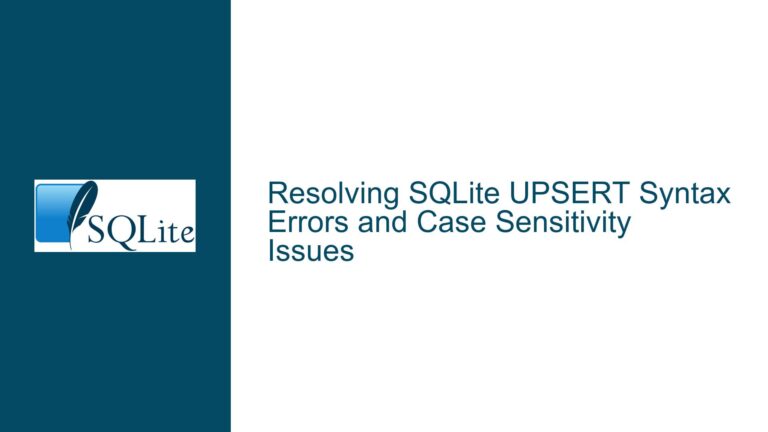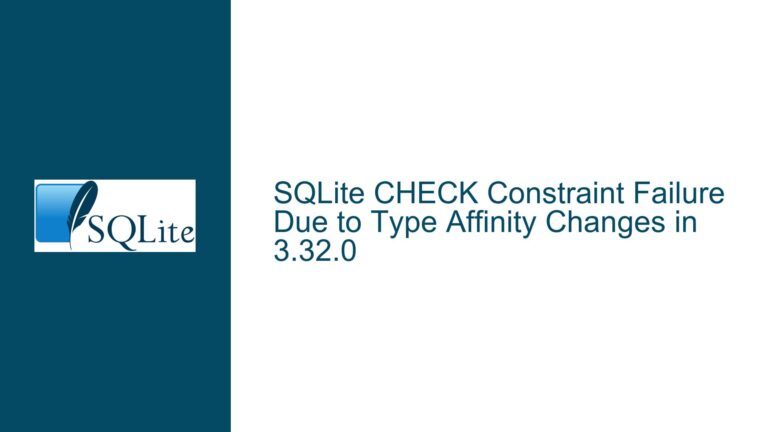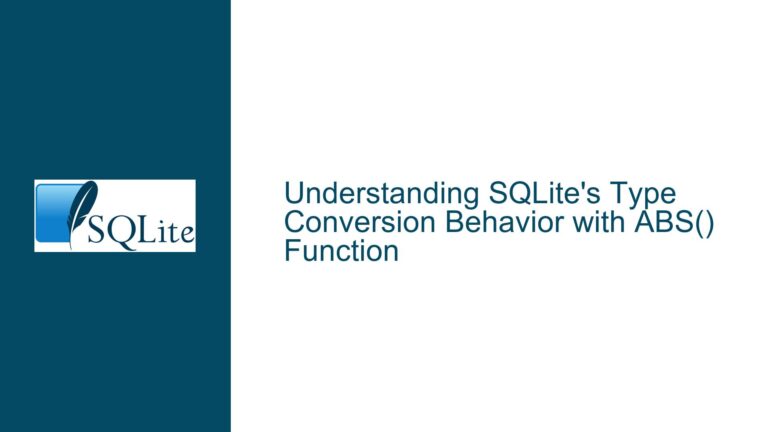Enhancing SQLite String Manipulation: Implementing LAST_INSTR and Reverse Search Functionality
The Need for Enhanced String Search and Manipulation in SQLite
SQLite, while being a powerful and lightweight database engine, has certain limitations when it comes to string manipulation functions. One of the most notable gaps is the absence of a built-in function to search for the last occurrence of a substring within a string. The existing INSTR function is designed to search from the beginning of the string, which can be limiting in scenarios where the last occurrence of a substring is needed. This limitation becomes particularly evident when dealing with file paths, URLs, or any string where the position of the last delimiter is crucial for further processing.
The INSTR function in SQLite returns the position of the first occurrence of a substring within a string. However, there is no equivalent function to find the last occurrence of a substring. This can lead to cumbersome and inefficient workarounds, especially when dealing with complex string manipulations. For example, extracting a file extension from a path requires identifying the last occurrence of the ‘.’ character. Without a LAST_INSTR function, this task becomes unnecessarily complicated.
Exploring the Limitations of INSTR and the Case for LAST_INSTR
The INSTR function in SQLite is defined as INSTR(X, Y), where X is the string to be searched, and Y is the substring to search for. The function returns the 1-based index of the first occurrence of Y in X. If Y is not found in X, the function returns 0. While this function is useful for many scenarios, it falls short when the requirement is to find the last occurrence of a substring.
Consider the following example:
SELECT INSTR('/home/user1/music/1.mp3', '.');
This query returns 20, which is the position of the first ‘.’ in the string. However, if the path contains multiple ‘.’ characters, as in /home/user1/./music/1.mp3, the INSTR function still returns 20, which is not the desired result if the goal is to extract the file extension. In this case, the last occurrence of ‘.’ is at position 22, but there is no built-in function to retrieve this value directly.
The absence of a LAST_INSTR function forces developers to resort to complex SQL queries or external extensions to achieve the desired functionality. This not only increases the complexity of the code but also impacts performance, especially when dealing with large datasets.
Proposed Solutions: Implementing LAST_INSTR and Reverse Search Functionality
To address the limitations of the INSTR function, several solutions have been proposed. One approach is to introduce a new function, LAST_INSTR, which would return the position of the last occurrence of a substring within a string. The syntax for this function could be similar to the existing INSTR function, with an additional parameter to specify the search direction.
For example:
SELECT LAST_INSTR('/home/user1/./music/1.mp3', '.');
This query would return 22, which is the position of the last ‘.’ in the string. This function would greatly simplify tasks such as extracting file extensions or identifying the last segment of a path.
Another proposed solution is to introduce a REVERSE function, which would reverse the characters in a string. This would allow developers to use the existing INSTR function in combination with REVERSE to achieve the same result as LAST_INSTR. For example:
SELECT LENGTH('/home/user1/./music/1.mp3') - INSTR(REVERSE('/home/user1/./music/1.mp3'), '.') + 1;
This query would also return 22, as it calculates the position of the last ‘.’ by reversing the string and using the INSTR function.
A third approach is to enhance the existing INSTR function by adding a third parameter to specify the search direction. For example:
SELECT INSTR('/home/user1/./music/1.mp3', '.', 1);
In this case, the third parameter 1 could indicate that the search should be performed from the end of the string. This would provide a more flexible and intuitive way to search for substrings without introducing new functions.
Evaluating the Proposed Solutions
Each of the proposed solutions has its own advantages and disadvantages. The LAST_INSTR function is the most straightforward and intuitive solution, as it directly addresses the need to find the last occurrence of a substring. However, it requires adding a new function to SQLite, which may not be feasible in all environments.
The REVERSE function approach is more versatile, as it can be used in combination with other string functions to achieve a wide range of string manipulations. However, it introduces additional complexity and may impact performance, especially when dealing with large strings.
The enhanced INSTR function with a third parameter offers a balance between simplicity and flexibility. It allows developers to specify the search direction without introducing new functions, making it easier to integrate into existing code. However, it requires modifying the existing INSTR function, which may not be backward compatible with all applications.
Practical Implementation and Workarounds
While waiting for official enhancements to SQLite, developers can implement workarounds to achieve the desired functionality. One common approach is to use recursive Common Table Expressions (CTEs) to simulate the LAST_INSTR function. For example:
WITH RECURSIVE split(l, n) AS (
SELECT 1, INSTR('/home/user1/./music/1.mp3', '.')
UNION ALL
SELECT l + 1, INSTR('/home/user1/./music/1.mp3', '.', n + 1)
FROM split
WHERE n > 0
)
SELECT MAX(n) AS last_instr FROM split;
This query uses a recursive CTE to find all occurrences of ‘.’ in the string and then selects the maximum value, which corresponds to the last occurrence.
Another workaround is to use the REPLACE and RTRIM functions to extract the last segment of a string. For example:
SELECT REPLACE('/home/user1/./music/1.mp3', RTRIM('/home/user1/./music/1.mp3', REPLACE('/home/user1/./music/1.mp3', '.', '')), '');
This query removes all characters up to the last ‘.’ and returns the remaining substring, which in this case is mp3.
Conclusion: The Path Forward for SQLite String Manipulation
The need for enhanced string manipulation functions in SQLite is clear. The absence of a LAST_INSTR function or a REVERSE function complicates tasks that require searching for the last occurrence of a substring. While workarounds exist, they are often cumbersome and inefficient, especially when dealing with large datasets.
The proposed solutions, including the introduction of a LAST_INSTR function, a REVERSE function, or an enhanced INSTR function with a third parameter, offer promising ways to address these limitations. Each solution has its own advantages and trade-offs, and the best approach may depend on the specific requirements of the application.
In the meantime, developers can use recursive CTEs or combinations of existing string functions to achieve the desired functionality. However, the addition of built-in support for these features would greatly simplify string manipulation in SQLite and improve the overall developer experience.
As SQLite continues to evolve, it is hoped that these enhancements will be considered for inclusion in future releases. Until then, developers must rely on creative workarounds and external extensions to meet their string manipulation needs.






